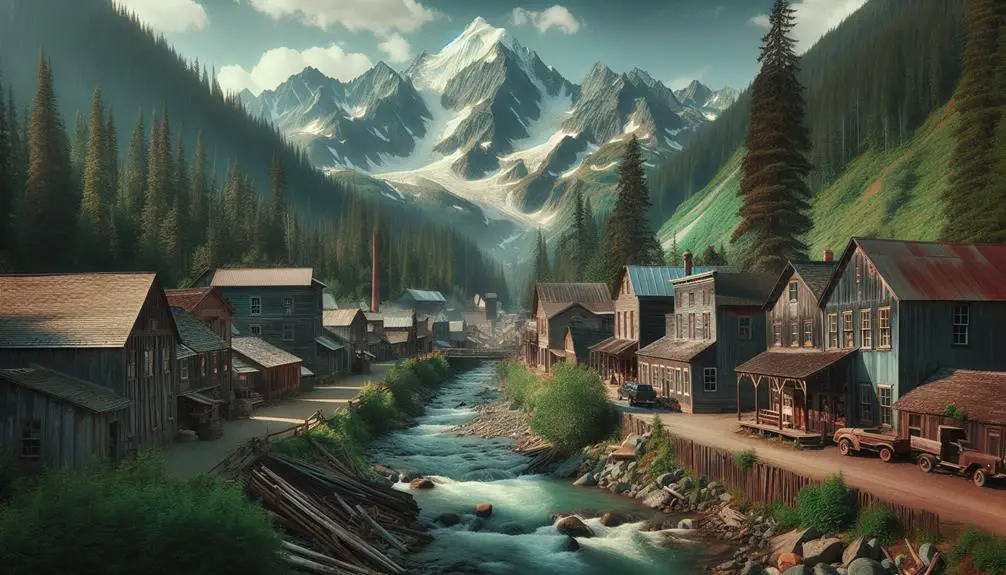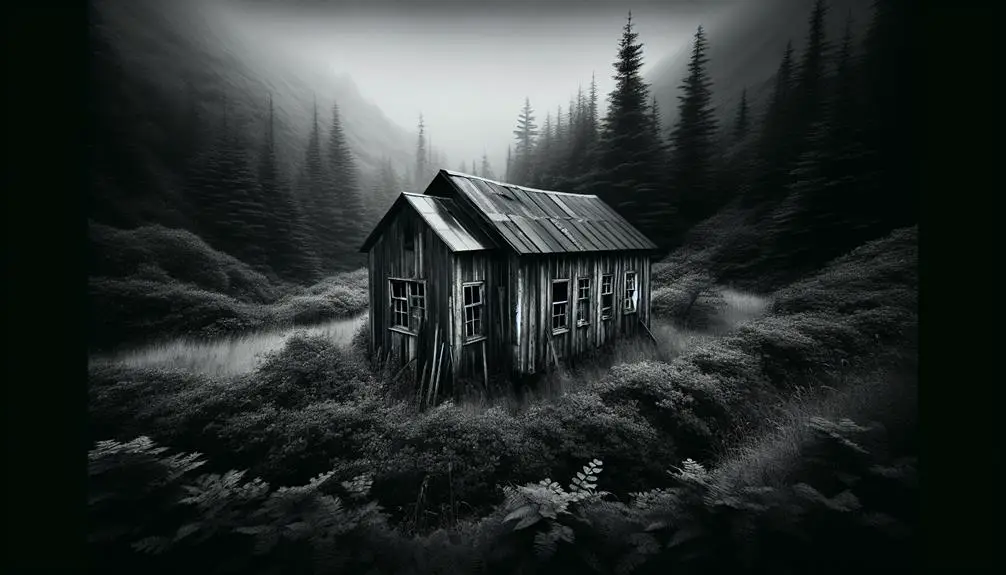Explore the Pacific Northwest's history through gold rush boomtowns, silver mining settlements, and copper mining communities. Witness the prosperity brought by silver, the labor disputes of copper mining, and the industrial revolution's coal towns attracting laborers. Discover abandoned ore processing centers, silent witnesses to past activity facing preservation challenges. These historic mining towns not only showcase the region's rich past but also highlight the resilience and struggles of those who shaped them.
Key Points
- Gold Rush boomtowns like Seattle and Portland were significant in the Pacific Northwest's mining history.
- Silver mining settlements such as Republic and Tonopah left a mark on the region.
- Copper mining communities like Butte and Kennecott faced labor disputes and environmental challenges.
- Coal towns like Roslyn and Black Diamond thrived on coal extraction during the Industrial Revolution.
- Abandoned ore processing centers in ghost towns reflect the region's mining legacy and pose environmental concerns.
Gold Rush Boomtowns
During the mid-1800s, Gold Rush boomtowns sprang up across the Pacific Northwest, transforming the region's landscape and economy. The rapid influx of miners and settlers led to the creation of bustling towns, fueled by the promise of striking it rich. However, as the gold reserves dwindled, many of these boomtowns became ghost towns, abandoned by all but the echoes of the past. Today, efforts are being made to preserve these historic sites, offering a glimpse into a bygone era.
The economic impact of these boomtowns was profound, shaping the development of the Pacific Northwest. The influx of wealth from gold mining boosted local economies, driving growth and infrastructure development. However, the environmental consequences were severe. Mining operations scarred the land, leaving behind polluted waterways and barren landscapes. Despite the economic benefits, the environmental toll serves as a stark reminder of the delicate balance between progress and preservation in the quest for riches.
Silver Mining Settlements
In the late 1800s, silver mining settlements dotted the rugged landscapes of the Pacific Northwest, their presence shaping both the economy and the environment of the region. The rush for silver brought forth a wave of prosperity to these remote areas, with towns like Silver City and Murray becoming vibrant centers of activity. However, as the silver mines eventually dried up, many of these settlements turned into ghost town remnants, frozen in time as echoes of the past. Despite their decline, efforts towards historical preservation have been made to conserve these sites, allowing visitors to glimpse into the bygone era of silver mining.
The economic impact of the silver mining settlements was profound, fueling growth and development in the region while also leaving a legacy of boom and bust cycles. On the other hand, the environmental consequences of silver mining, such as deforestation, water contamination, and soil degradation, have had lasting effects on the local ecosystems. Balancing the historical significance with the need for environmental restoration remains a challenge in these once-thriving silver mining communities.
Copper Mining Communities
The legacy of silver mining settlements in the Pacific Northwest gives way to a new chapter as we turn our focus to the copper mining communities that emerged in this rugged region.
Copper Mining Communities in the Pacific Northwest:
- Boomtowns: The discovery of copper led to the rapid development of bustling towns, attracting prospectors and miners seeking their fortunes in the rich copper deposits.
- Labor Strikes: The demand for copper fueled intense labor disputes as workers fought for better wages, improved working conditions, and fair treatment in the mines.
- Environmental Impact: The extraction of copper had a profound impact on the environment, leading to deforestation, water pollution, and habitat destruction. Efforts to mitigate these effects have become a critical aspect of modern mining operations in the region.
As you explore the history of copper mining communities in the Pacific Northwest, you'll encounter tales of resilience, struggle, and the complex interplay between human ambition and the natural world.
Coal Towns of the Northwest
Nestled amidst the rugged landscapes of the Pacific Northwest, coal towns emerged as vibrant communities shaped by the demands of the mining industry. During the Industrial Revolution, these towns thrived on the extraction of coal, becoming hubs of activity and commerce. The presence of coal in abundance attracted laborers from far and wide, seeking opportunities in the mines. As the coal industry boomed, labor unions played an important role in advocating for better working conditions and fair wages for miners.
The coal towns of the Northwest were characterized by a unique blend of industry and community life. The sound of machinery and the sight of coal-laden trains were constants in these bustling towns. Despite the challenges faced by miners in hazardous working conditions, the tight-knit nature of these communities fostered resilience and solidarity among residents. Labor unions emerged as influential forces, championing the rights of workers and reshaping the dynamics of the mining industry in the region. The legacy of these coal towns endures as a proof of the industrious spirit of the Pacific Northwest.
Abandoned Ore Processing Centers
Amidst the remnants of once-thriving industrial complexes, echoes of a bygone era resonate through the abandoned ore processing centers of the Pacific Northwest. These industrial relics stand as silent witnesses to the bustling activity that once defined these areas.
Here's a closer look at these sites:
- Ghost Town Remnants: Many of these ore processing centers are now located in ghost towns, where empty buildings and rusting machinery serve as a reminder of the communities that once thrived in these areas.
- Environmental Impact: The abandoned ore processing centers often pose essential environmental challenges, with the potential for contamination from leftover chemicals and waste materials. Efforts to mitigate these impacts are vital to safeguarding the surrounding ecosystems.
- Preservation Efforts: Some organizations and local communities are working towards preserving these sites as historical landmarks, aiming to maintain their cultural significance while ensuring they're safe for visitors to explore.
As you wander through these abandoned centers, you can't help but feel a sense of nostalgia for a time long past, intertwined with a duty to protect and preserve these remnants of history.
Frequently Asked Questions
How Did the Discovery of Gold Impact the Indigenous Peoples of the Pacific Northwest?
When gold was discovered, the impact on indigenous peoples in the Pacific Northwest was significant. Communities faced cultural displacement as settlers moved in, altering traditions and territories. The consequences of this historical event were profound.
What Environmental Consequences Resulted From the Silver Mining Operations in the Region?
When silver mining boomed, water contamination and deforestation followed. Wildlife habitat suffered, and soil erosion escalated, leaving a scarred landscape. The environmental consequences of these operations were significant, impacting ecosystems for years.
How Did the Copper Mining Communities in the Pacific Northwest Contribute to the Development of the Local Economy?
Like a river flowing through a valley, the copper mining communities in the Pacific Northwest fueled economic growth and community development. By providing job opportunities and investing in infrastructure, these towns shaped the region's prosperity.
What Role Did the Coal Towns of the Northwest Play in Shaping the Region's Industrial History?
In the history of the Pacific Northwest, coal towns were pivotal in shaping industrial history. Labor relations and workforce dynamics evolved alongside technological advancements. Machinery innovations revolutionized mining practices, leaving a lasting impact on the region.
Are There Any Efforts Being Made to Preserve the History and Legacy of the Abandoned Ore Processing Centers in the Pacific Northwest?
To preserve the legacy of abandoned ore processing centers in the Pacific Northwest, community involvement is key. Preservation efforts focus on conserving historical sites, educating the public, and ensuring these remnants of the past endure for future generations.



